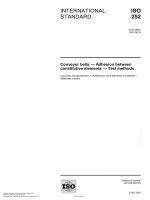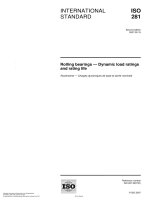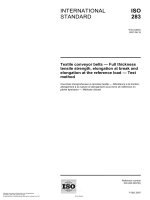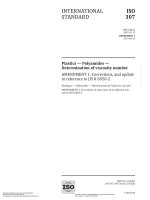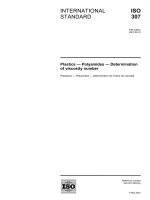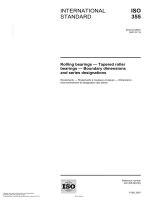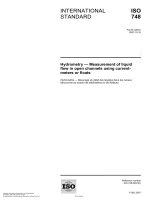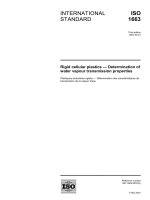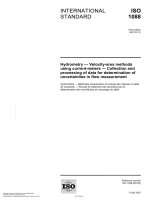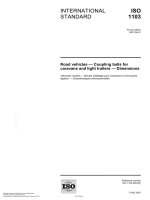Tiêu chuẩn iso 16042 2007
Bạn đang xem bản rút gọn của tài liệu. Xem và tải ngay bản đầy đủ của tài liệu tại đây (149.72 KB, 12 trang )
--`,,```,,,,````-`-`,,`,,`,`,,`---
INTERNATIONAL
STANDARD
ISO
16042
First edition
2007-02-01
Iron ores — Guidelines for the use of
certified reference materials (CRMs)
Minerais de fer — Lignes directrices pour l'utilisation des matériaux de
référence certifiés
Reference number
ISO 16042:2007(E)
Copyright International Organization for Standardization
Provided by IHS under license with ISO
No reproduction or networking permitted without license from IHS
© ISO 2007
Not for Resale
ISO 16042:2007(E)
PDF disclaimer
This PDF file may contain embedded typefaces. In accordance with Adobe's licensing policy, this file may be printed or viewed but
shall not be edited unless the typefaces which are embedded are licensed to and installed on the computer performing the editing. In
downloading this file, parties accept therein the responsibility of not infringing Adobe's licensing policy. The ISO Central Secretariat
accepts no liability in this area.
Details of the software products used to create this PDF file can be found in the General Info relative to the file; the PDF-creation
parameters were optimized for printing. Every care has been taken to ensure that the file is suitable for use by ISO member bodies. In
the unlikely event that a problem relating to it is found, please inform the Central Secretariat at the address given below.
© ISO 2007
All rights reserved. Unless otherwise specified, no part of this publication may be reproduced or utilized in any form or by any means,
electronic or mechanical, including photocopying and microfilm, without permission in writing from either ISO at the address below or
ISO's member body in the country of the requester.
ISO copyright office
Case postale 56 • CH-1211 Geneva 20
Tel. + 41 22 749 01 11
Fax + 41 22 749 09 47
Web www.iso.org
Published in Switzerland
ii
Copyright International Organization for Standardization
Provided by IHS under license with ISO
No reproduction or networking permitted without license from IHS
© ISO 2007 – All rights reserved
Not for Resale
--`,,```,,,,````-`-`,,`,,`,`,,`---
Adobe is a trademark of Adobe Systems Incorporated.
ISO 16042:2007(E)
Contents
Page
Foreword............................................................................................................................................................ iv
Introduction ........................................................................................................................................................ v
1
Scope ..................................................................................................................................................... 1
2
Normative references ........................................................................................................................... 1
3
Terms and definitions........................................................................................................................... 1
4
Principle ................................................................................................................................................. 1
5
Ore types ............................................................................................................................................... 2
6
Mass-fraction difference ...................................................................................................................... 2
7
Extraction of the test portion............................................................................................................... 2
8
Two-bottle strategy............................................................................................................................... 3
9
Alteration of the CRM ........................................................................................................................... 3
10
Shewhart control charts....................................................................................................................... 3
11
Acceptance of analytical values.......................................................................................................... 4
12
Test report ............................................................................................................................................. 4
--`,,```,,,,````-`-`,,`,,`,`,,`---
Annex A (informative) Example of the calculation of mass-fraction difference .......................................... 5
iii
© ISO 2007 – All rights reserved
Copyright International Organization for Standardization
Provided by IHS under license with ISO
No reproduction or networking permitted without license from IHS
Not for Resale
ISO 16042:2007(E)
Foreword
ISO (the International Organization for Standardization) is a worldwide federation of national standards bodies
(ISO member bodies). The work of preparing International Standards is normally carried out through ISO
technical committees. Each member body interested in a subject for which a technical committee has been
established has the right to be represented on that committee. International organizations, governmental and
non-governmental, in liaison with ISO, also take part in the work. ISO collaborates closely with the
International Electrotechnical Commission (IEC) on all matters of electrotechnical standardization.
International Standards are drafted in accordance with the rules given in the ISO/IEC Directives, Part 2.
The main task of technical committees is to prepare International Standards. Draft International Standards
adopted by the technical committees are circulated to the member bodies for voting. Publication as an
International Standard requires approval by at least 75 % of the member bodies casting a vote.
Attention is drawn to the possibility that some of the elements of this document may be the subject of patent
rights. ISO shall not be held responsible for identifying any or all such patent rights.
--`,,```,,,,````-`-`,,`,,`,`,,`---
ISO 16042 was prepared by Technical Committee ISO/TC 102, Iron ore and direct reduced iron,
Subcommittee SC 2, Chemical analysis.
iv
Copyright International Organization for Standardization
Provided by IHS under license with ISO
No reproduction or networking permitted without license from IHS
© ISO 2007 – All rights reserved
Not for Resale
ISO 16042:2007(E)
Introduction
This International Standard is intended for use in conjunction with other International Standards for the
chemical analysis of iron ores. It describes recommended procedures for the use of iron ore certified
reference materials (CRMs) in verifying the trueness of chemical analysis. It is recommended that CRMs also
be used for general quality assurance purposes in laboratories where the analysis of iron ores is carried out
regularly.
It is also recommended that CRMs be, from time to time, introduced as unknowns in laboratory proficiency
testing schedules.
--`,,```,,,,````-`-`,,`,,`,`,,`---
© ISO 2007 – All rights reserved
Copyright International Organization for Standardization
Provided by IHS under license with ISO
No reproduction or networking permitted without license from IHS
Not for Resale
v
--`,,```,,,,````-`-`,,`,,`,`,,`---
Copyright International Organization for Standardization
Provided by IHS under license with ISO
No reproduction or networking permitted without license from IHS
Not for Resale
INTERNATIONAL STANDARD
ISO 16042:2007(E)
Iron ores — Guidelines for the use of certified reference
materials (CRMs)
1
Scope
This International Standard describes recommended procedures for the use of CRMs that have been
prepared and certified in accordance with ISO 11459. Such CRMs are used by laboratories to carry out the
trueness tests as specified in the various International Standards for the chemical analysis of iron ores, to
verify the analysis of shipment samples and the ongoing reliability of analytical results.
2
Normative references
The following referenced documents are indispensable for the application of this document. For dated
references, only the edition cited applies. For undated references, the latest edition of the referenced
document (including any amendments) applies.
ISO 3082, Iron ores — Sampling and sample preparation procedures
ISO 8258:1991, Shewhart control charts
ISO 11459, Iron ores — Certified reference materials — Preparation and certification for use in chemical
analysis
ISO 11323, Iron ore and direct reduced iron — Vocabulary
ISO Guide 30, Terms and definitions used in connection with reference materials
ISO Guide 33, Uses of certified reference materials
ISO Guide 35, Reference materials — General and statistical principles for certification
3
Terms and definitions
For the purposes of this document, the terms and definitions given in ISO 11323 and ISO Guide 30 apply.
4
Principle
The uses of CRMs as specified in this document are as follows:
a)
to verify the trueness of analysis of shipment samples that are used to determine the commercial value of
a cargo or any specified quantity of iron ore sampled according to ISO 3082 and delivered from the
vendor to the purchaser;
b)
to demonstrate the ongoing ability of a laboratory to provide analysis of a defined accuracy and precision;
c)
to test the proficiency of a laboratory to carry out the chemical analysis of iron ores.
--`,,```,,,,````-`-`,,`,,`,`,,`---
1
© ISO 2007 – All rights reserved
Copyright International Organization for Standardization
Provided by IHS under license with ISO
No reproduction or networking permitted without license from IHS
Not for Resale
ISO 16042:2007(E)
The use of CRMs for the purpose of standardization of titrants, or calibration of analytical equipment, is
specifically excluded.
Further uses of certified reference materials are outlined in ISO Guide 33.
5
Ore types
International Standards for the chemical analysis of iron ores specify that the certified reference material be of
a mineralogical ore type similar to the sample whose chemical constituents are to be determined. The massfraction ranges of the elements to be determined between the CRM and the test sample should be as
specified in Clause 6.
The contributing ore sources derived from single or multiple mines, blended to produce a traded iron ore, may
exhibit widely varying characteristics. It is therefore recommended that producers of iron ore are pro-active in
ensuring that the blend of iron ores produced for international trade is represented by a specific CRM. Ideally,
each traded ore type should be represented, with elemental mass fractions close to typical.
Procedures for the certification of CRMs in general are given in ISO Guide 35, and procedures for the
certification of iron ore CRMs in particular are given in ISO 11459.
6
Mass-fraction difference
The allowable absolute differences in mass fractions of various elements between the test sample and the
CRM can be calculated using the following equation for elemental mass fractions up to 10 %:
Rc = C s ±
( −10,771 ln C s + 25,4) C s
200
where
Rc is the mass-fraction range;
Cs is the mass fraction of sample.
An example of the calculation of mass-fraction difference is given in Annex A.
It is recommended that, for the mass fraction of total iron (% Fe), the CRM should not vary by more than
0,5 % Fe from the mass fraction of the test sample.
7
Extraction of the test portion
Iron ore CRMs are usually sold in 100 g lots. Typically, for the purpose of analysis, a test portion of 0,38 g to
1,00 g in mass is used. The extraction of the test portion is basically a sampling exercise, which should be
carried out on the full quantity of the unit mass by which the CRM is supplied. The extraction of test portions
from a diminishing quantity out of one bottle is not recommended.
It is recommended that the total contents of the bottle of CRM prior to its first use be divided into portions that
match the intended test portions. Each portion shall be packed in an inert plastic or glass sealed container,
with a tightly fitting screw-cap plastic lid, preferably with a plastic insert in the top of the bottle, or a heavy-duty
plastic bag or vial having a tightly fitting lid. Plastic containers and caps/inserts should be checked to ensure
that the electrostatic properties of the plastic do not cause particles to stick selectively to the plastic, thereby
causing segregation of the material. Bottles shall not have lids with cardboard inserts, as these can cause
contamination of the samples. Samples shall not be packed in paper bags, as the paper can contaminate
samples used for low levels of certain elements. Containers should be labelled as follows:
--`,,```,,,,````-`-`,,`,,`,`,,`---
2
Copyright International
Organization for Standardization
Provided by IHS under license with ISO
No reproduction or networking permitted without license from IHS
© ISO 2007 – All rights reserved
Not for Resale
ISO 16042:2007(E)
a)
identification by name or number of the CRM;
b)
the serial number of the bottle in which the CRM was supplied; should the CRM manufacturer not have
supplied a bottle number, it is recommended that the laboratory give each bottle its own number;
c)
the serial number of the test portion as extracted.
EXAMPLE
JSS 820-2/100/5 represents the fifth portion extracted out of bottle 100 from CRM JSS 820-2.
The division of the CRM shall be effected by rotary sample division or riffle splitter division. In each case, the
minimum increments represented in a test portion should be 15 to 20 in number.
To minimize bias in sampling, test portions shall be taken at random.
8
Two-bottle strategy
The number of replicate analyses carried out on a CRM shall be a minimum of two. It is recommended that a
duplicate be derived from separate bottles of the CRM.
9
Alteration of the CRM
Alterations to the mass fractions of the various certified data of a CRM can occur in a number of ways. The
strategy outlined in Clause 7 assists in avoiding this problem or at least limiting it to a single occurrence. The
two-bottle strategy (Clause 8) assists in the detection of the above. Good housekeeping is a basic laboratory
requirement and should be in evidence in all laboratories.
The following rules apply:
a)
magnetic spatulas and magnetized equipment shall not be used;
b)
electrostatically charged equipment shall be discharged or its use avoided;
c)
containers used for storage of CRMs shall not exhibit electrostatic surface charges;
d)
vibrating spatulas shall not be used for dispensing test portions;
e)
CRMs shall not be stored in drying ovens;
f)
platinum ware used for fusions shall be clean and shall not cause any contamination;
g)
glassware used in analytical determinations shall be clean and not cause contamination;
h)
exposure to acid and other vapours shall be avoided;
i)
storage in places subject to vibrations shall be avoided.
In all cases, CRMs shall be stored in accordance with manufacturers' recommendations.
10 Shewhart control charts
For each CRM used on a regular basis within a laboratory, Shewhart control charts shall be constructed in
accordance with ISO 8258. Separate charts should be constructed for bottle 1 and bottle 2 or the different
bottles should be identifiable on the chart. Whilst the trueness test for each use of the CRM still applies, the
use of the Shewhart chart is recommended to identify outliers, trends and runs along the principles outlined in
ISO 8258:1991, Figure 2 “Tests for assignable causes”. The Shewhart chart should be updated for every
newly completed analysis of the CRM.
--`,,```,,,,````-`-`,,`,,`,`,,`---
3
© ISO 2007 – All rights reserved
Copyright International Organization for Standardization
Provided by IHS under license with ISO
No reproduction or networking permitted without license from IHS
Not for Resale
ISO 16042:2007(E)
11 Acceptance of analytical values
The result obtained for the certified reference material shall be such that the difference between this result and
the certified value of the certified reference material is statistically insignificant. For a certified reference
material that has been analysed by at least 10 laboratories using method(s) that are comparable in both
accuracy and precision, the following condition may be used to test the significance of the difference:
2
+
S Lc
Ac − A u 2
2
S wc
n wc
Nc
+ σ L2 +
σ d2
n
where
Ac is the certified value;
A
is the result or the mean of results obtained for the certified reference material;
SLc is the between-laboratories standard deviation of the certifying laboratories;
Swc is the within-laboratory standard deviation of the certifying laboratories;
--`,,```,,,,````-`-`,,`,,`,`,,`---
nwc is the average number of replicate determinations in the certifying laboratories;
Nc is the number of certifying laboratories;
n
is the number of replicate determinations on the reference material (it is recommended that n = 2 as
a minimum);
σL is the between-laboratory standard deviation, as derived from the precision equations of an
ISO/TC102/SC 2 analytical method;
σd is the within-laboratory standard deviation, as derived from the precision equations of the relevant
analytical method.
If the condition is satisfied, i.e. if the left-hand side is less than or equal to the right-hand side, then the
difference Ac − A is statistically insignificant; otherwise it is statistically significant.
If the difference is significant, the analysis shall be repeated simultaneously with an analysis of the test
sample. If the difference is again significant, the procedure shall be repeated using a different certified
reference material of the same type of ore.
If the range of the two values for the test sample is outside the independent duplicate limit calculated
according to the International Standard being used, one or more additional tests shall be carried out.
Acceptability of the results for the test sample shall, in each case, be subject to the acceptability of the results
for the certified reference material.
It is not recommended that reference materials that have only been certified by one laboratory be used.
12 Test report
The analytical results of a CRM used to verify the analysis of a shipment sample shall be reported, together
with the data obtained on the shipment sample if requested by the trading parties. The laboratory shall keep
traceable records of CRM test results.
4
Copyright International Organization for Standardization
Provided by IHS under license with ISO
No reproduction or networking permitted without license from IHS
© ISO 2007 – All rights reserved
Not for Resale
ISO 16042:2007(E)
Annex A
(informative)
Substituting the analyte mass-fraction range with 0,235 %:
Rc = 0,235 ±
( −10,771× ln (0,235) + 25,4) × 0,235
%
200
--`,,```,,,,````-`-`,,`,,`,`,,`---
Example of the calculation of mass-fraction difference
Solving for the natural logarithm of 0,235:
Rc = 0,235 ±
( −10,771× ( −1,488 2) + 25,4) × 0,235
%
200
Solving the numerator:
Rc = 0,235 ±
9,634 6
%
200
Solving for the mass-fraction range gives:
Rc = 0,235 ± 0,048 %
Thus, at an analyte mass fraction of 0,235 %, the CRM mass fraction should preferably lie between 0,187 %
and 0,283 %.
5
© ISO 2007 – All rights reserved
Copyright International Organization for Standardization
Provided by IHS under license with ISO
No reproduction or networking permitted without license from IHS
Not for Resale
ISO 16042:2007(E)
--`,,```,,,,````-`-`,,`,,`,`,,`---
ICS 73.060.10
Price based on 5 pages
© ISO 2007 – All rights reserved
Copyright International Organization for Standardization
Provided by IHS under license with ISO
No reproduction or networking permitted without license from IHS
Not for Resale
